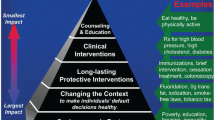Abstract
The field of hospital-based injury and violence prevention (HIVP) is ever evolving and changing. Expectations for HIVP programs have shifted away from one-time outreach events, like health and safety fairs, to developing an organized approach to injury prevention using public health informed, multi-layered, evidence-based strategies. The purpose of this chapter is to describe the integral role best available scientific evidence plays as a foundation for developing an organized approach to injury prevention to improve population health. Readers will be introduced to concepts related to the development of infrastructure supporting evidence-based practice, describing how to integrate methodical program evaluation, and the importance of contributing to ongoing scientific research in the field of hospital-based injury and violence prevention.
Access this chapter
Tax calculation will be finalised at checkout
Purchases are for personal use only
Similar content being viewed by others
References
Jacobs JA, Jones E, Gabella BA, Spring B, Brownson RC. Peer reviewed: tools for implementing an evidence-based approach in public health practice. Prev Chronic Dis. 2012;9:E116.
Melnyk BM, Fineout-Overholt E, Mays MZ. The evidence-based practice beliefs and implementation scales: psychometric properties of two new instruments. Worldviews Evid-Based Nurs. 2008;5(4):208–16.
Sackett DL, Straus SE, Richardson WS, Rosenberg W, Haynes RB. Evidence-based medicine: how to practice and teach EBM. 2nd ed. London: Churchill Livingstone; 2000.
Melnyk BM, Fineout-Overholt E. Evidence-based practice in nursing and healthcare: a guide to best practice. 3rd ed. Philadelphia: Lippincott Williams and Wilkins; 2005.
Newhouse RP. Creating infrastructure supportive of evidence-based nursing practice: leadership strategies. Worldviews Evid-Based Nurs. 2007;4(1):21–9.
Wolf L. Research and evidence-based practice. In: Emergency nursing core curriculum. St. Louis (MO): Elsevier; 2018. p. 698–707.
Melnyk BM. Strategies for overcoming barriers in implementing evidence-based practice. Pediatr Nurs. 2002;28(2):159–61.
Trauma Center Injury and Violence Prevention Programs. Key findings from an environmental scan. Atlanta (G): Safe States Alliance; 2017.
Stillwell SB, Fineout-Overholt E, Melnyk BM, Williamson KM. Evidence-based practice, step by step: searching for the evidence. AJN: Am J Nurs. 2010;110(5):41–7.
Straus SE. Evidence-based medicine: how to practice and teach EBM. 3rd ed. Edinburgh: Elsevier/Churchill Livingstone; 2005.
Ford LG, Melnyk BM. The underappreciated and misunderstood PICOT question: a critical step in the EBP process. Worldviews Evid-Based Nurs. 2019;16(6):422.
Goldet G, Howick J. Understanding GRADE: an introduction. J Evid Based Med. 2013;6(1):50–4.
Buccheri RK, Sharifi C. Critical appraisal tools and reporting guidelines for evidence-based practice. Worldviews Evid-Based Nurs. 2017;14(6):463–72.
Fineout-Overholt E, Melnyk BM, Stillwell S, Williamson K. Evidence-based practice step by step: critical appraisal of the evidence: part I. Am J Nurs. 2010;110(7):47–52.
The Centre for Evidence-Based Medicine (CEBM). Critical Appraisal Tools. 2022. https://www.cebm.ox.ac.uk/resources/ebm-tools/critical-appraisal-tools. Accessed 1 June 2022
Ciliska D, Thomas H, Buffett M. A compendium of critical appraisal tools for public health practice. 2012. https://www.nccmt.ca/uploads/media/media/0001/01/5aad550fc93cb202f01048e98b174b5e70233359.pdf. Accessed 30 April 2021
Cunningham R, Knox L, Fein J, Harrison S, Frisch K, Walton M, Dicker R, Calhoun D, Becker M, Hargarten SW. Before and after the trauma bay: the prevention of violent injury among youth. Ann Emerg Med. 2009;53(4):490–500.
Smith R, Dobbins S, Evans A, Balhotra K, Dicker RA. Hospital-based violence intervention: risk reduction resources that are essential for success. J Trauma Acute Care Surg. 2013;74(4):976–82.
Affinati S, Patton D, Hansen L, Ranney M, Christmas AB, Violano P, Sodhi A, Robinson B, Crandall M. Hospital-based violence intervention programs targeting adult populations: an eastern Association for the Surgery of trauma evidence-based review. Trauma Surg Acute Care Open. 2016;1:e000024. https://doi.org/10.1136/tsaco-2016-000024.
Community Preventive Services Task Force (n.d). About The Community Guide. http://www.thecommunityguide.org. Accessed 6 April 2020
U.S. Department of Health and Human Services, National Institutes of Health, National Cancer Institute. Theory at a glance: A guide for health promotion practice. 2005. http://www.sbccimplementationkits.org/demandrmnch/wp-content/uploads/2014/02/Theory-at-a-Glance-A-Guide-For-Health-Promotion-Practice.pdf. Accessed 30 April 2021
Brownson RC, Fielding JE, Maylahn CM. Evidence-based public health: a fundamental concept for public health practice. Annu Rev Public Health. 2009;21(30):175–201.
National Collaborating Centre for methods and tools, McMaster University. Evidence-Informed Decision Making 2018. https://www.nccmt.ca/uploads/media/media/0001/01/4504c27e14836059b8fd3ce3b3eaac2ed2ce6ed6.pdf. Accessed 30 April 2021
Rosswurm MA, Larrabee JH. A model for change to evidence-based practice. Image: the. J Nurs Scholarsh. 1999;31(4):317–22.
Rossi PH, Lipsey MW, Henry GT. Evaluation: a systematic approach. Sage Publications; 2018.
Smith LS, Wilkins N. Mind the gap: approaches to addressing the research-to-practice, practice-to-research chasm. J Public Health Manag Pract: JPHMP. 2018;24(Suppl 1):S6.
Maljanian R, Caramanica L, Taylor SK, MacRae JB, Beland DK. Evidence-based nursing practice, part 2: building skills through research roundtables. JONA. J Nurs Adm. 2002;32(2):85–90. https://doi.org/10.1097/00005110-200202000-00006.
Author information
Authors and Affiliations
Corresponding author
Editor information
Editors and Affiliations
Rights and permissions
Copyright information
© 2023 Springer Nature Switzerland AG
About this chapter
Cite this chapter
Edwards, C., Unni, P. (2023). Ensuring an Evidence-Based Approach to Injury Prevention Interventions. In: Adams, C., Tinkoff, G. (eds) Hospital-based Injury and Violence Prevention Programs. Springer, Cham. https://doi.org/10.1007/978-3-031-20357-2_6
Download citation
DOI: https://doi.org/10.1007/978-3-031-20357-2_6
Published:
Publisher Name: Springer, Cham
Print ISBN: 978-3-031-20356-5
Online ISBN: 978-3-031-20357-2
eBook Packages: MedicineMedicine (R0)




